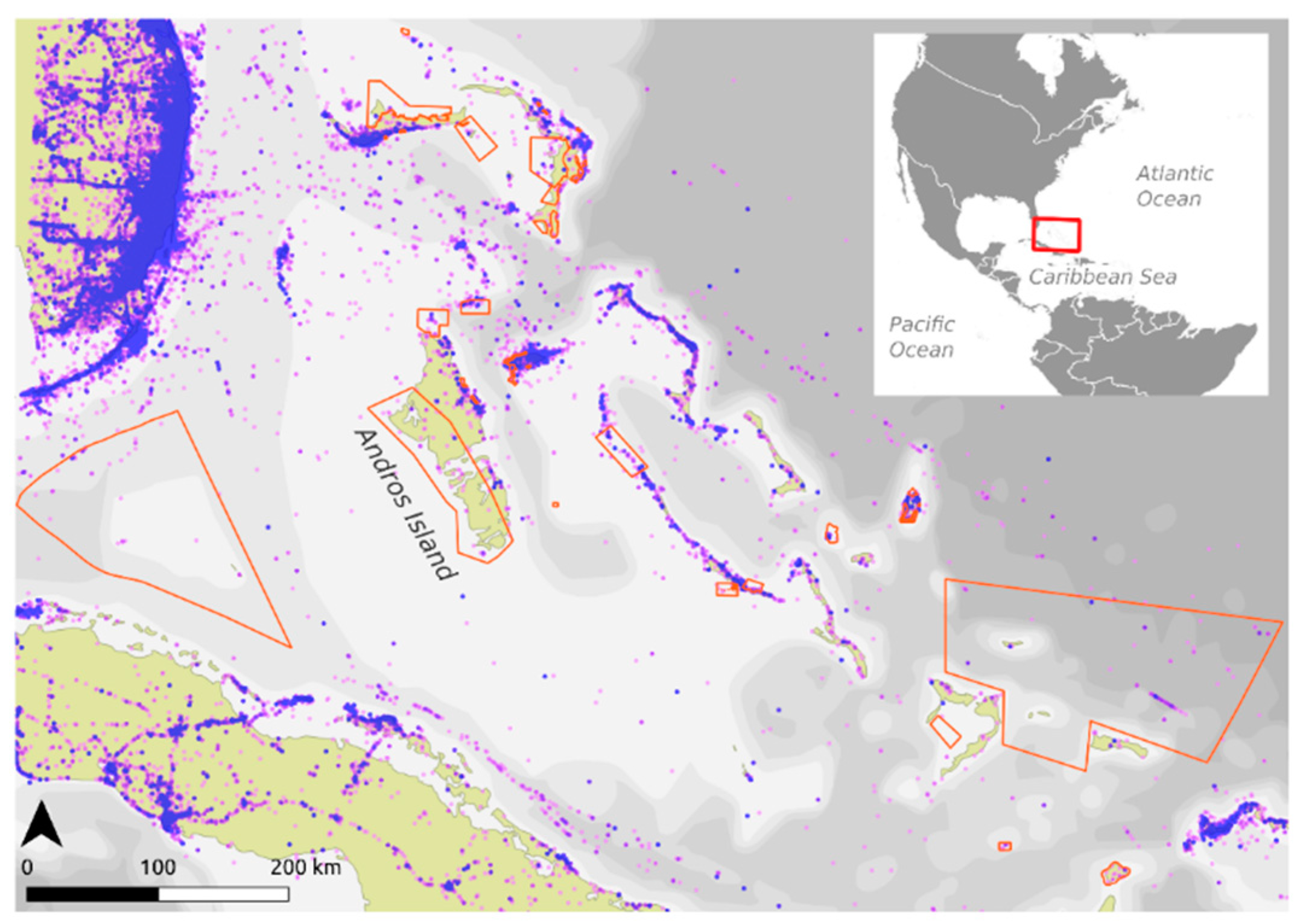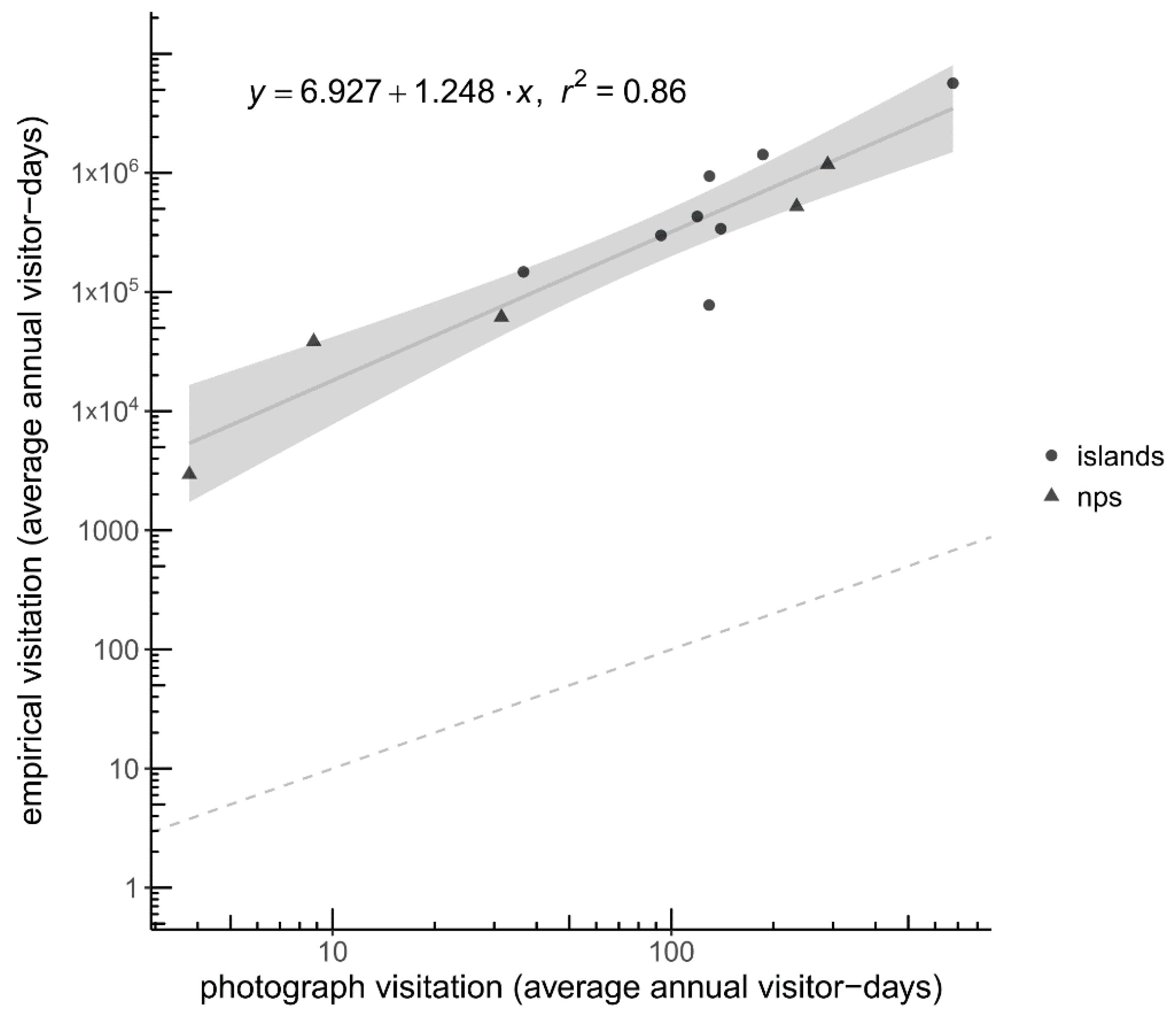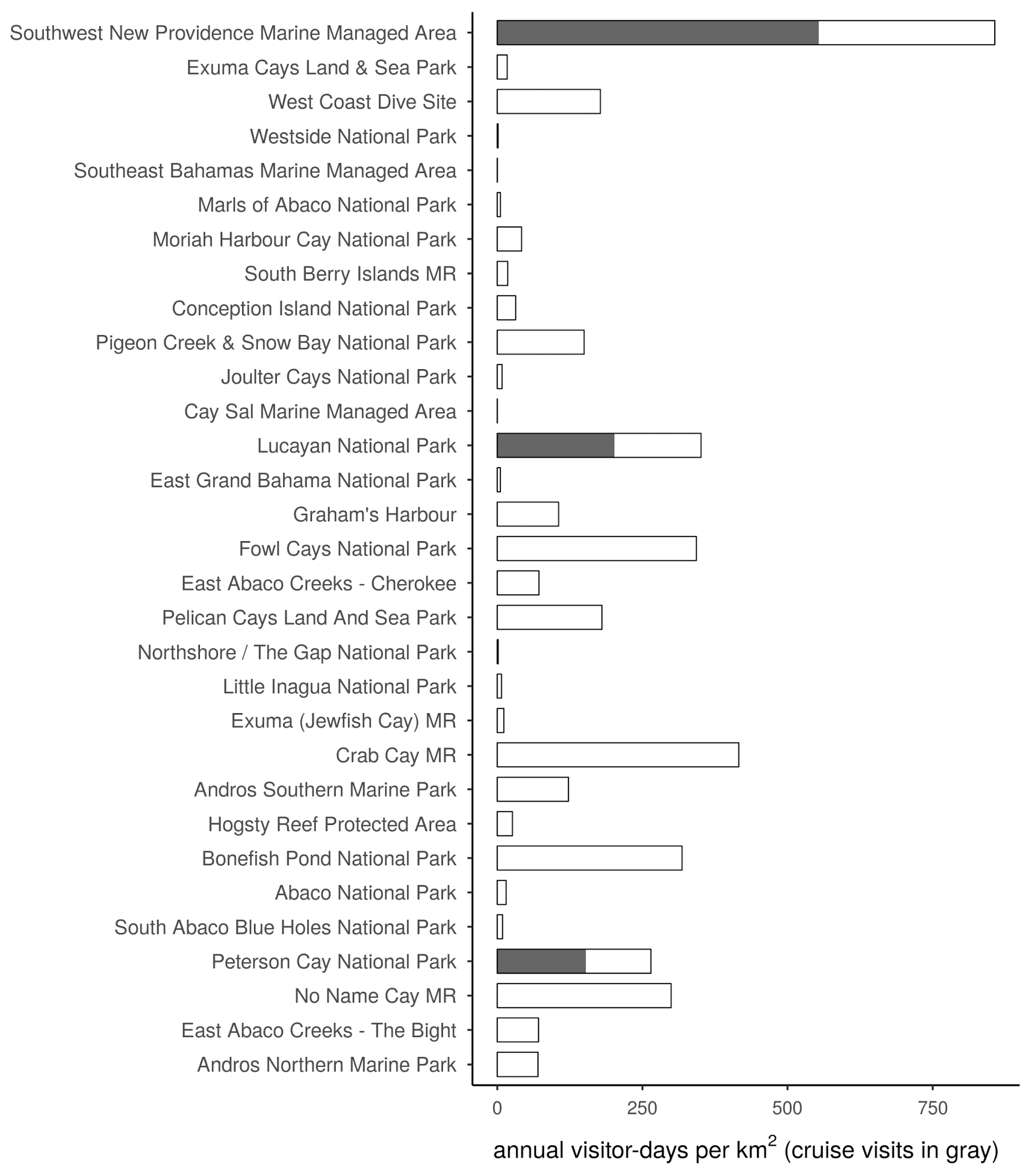Advancing Sustainable Development and Protected Area Management with Social Media-Based Tourism Data
Abstract
1. Introduction
2. Materials and Methods
2.1. Study Setting and Existing Planning Efforts
2.2. Comparing Social Media Data and On-Site Counts of Visitors in the Caribbean
2.3. Predicting Visitation Rates to Bahamian Marine Protected Areas
2.4. Distribution of Visitors, Expenditures, and Nature-Based Employment on Andros
2.5. Factors Influencing Visitation on Andros
3. Results
3.1. Testing PUD Visitation in the Caribbean
3.2. Visitation to Bahamian Marine Protected Areas
3.3. Visitation, Expenditures, and Nature-Based Employment on Andros
3.4. Factors That Influence Visitation on Andros
4. Discussion
5. Conclusions
Supplementary Materials
Author Contributions
Funding
Institutional Review Board Statement
Informed Consent Statement
Data Availability Statement
Acknowledgments
Conflicts of Interest
References
- McClung, M.R.; Seddon, P.J.; Massaro, M.; Setiawan, A.N. Nature-based tourism impacts on yellow-eyed penguins Megadyptes antipodes: does unregulated visitor access affect fledging weight and juvenile survival? Biol. Conserv. 2004, 119, 279–285. [Google Scholar] [CrossRef]
- Reed, S.E.; Merenlender, A.M. Quiet, Nonconsumptive Recreation Reduces Protected Area Effectiveness. Conserv. Lett. 2008, 1, 146–154. [Google Scholar] [CrossRef]
- Pirotta, E.; Lusseau, D. Managing the wildlife tourism commons. Ecol. Appl. 2015, 25, 729–741. [Google Scholar] [CrossRef]
- Cooper, E.; Burke, L.M.; Bood, N.D. Coastal Capital, Belize: The Economic Contribution of Belize’s Coral Reefs and Mangroves; World Resources Institute: Washington, DC, USA, 2009. [Google Scholar]
- Spalding, M.; Burke, L.; Wood, S.A.; Ashpole, J.; Hutchison, J.; zu Ermgassen, P. Mapping the global value and distribution of coral reef tourism. Mar. Policy 2017, 82, 104–113. [Google Scholar] [CrossRef]
- Cline, W. Shark Diving Overview for the Islands of The Bahamas; Cline Marketing Group: Nassau, Bahamas, 2008. [Google Scholar]
- Haas, A.R.; Fedler, T.; Brooks, E.J. The contemporary economic value of elasmobranchs in The Bahamas: Reaping the rewards of 25 years of stewardship and conservation. Biol. Conserv. 2017, 207, 55–63. [Google Scholar] [CrossRef]
- Fedler, T. The economic Impact of Flats Fishing in The Bahamas; The Bahamian Flats Fishing Alliance: Nassau, Bahamas, 2010. [Google Scholar]
- Blackwell, B.; Brumbaugh, D.R.; Dahlgren, C.P. Economic Benefits of the South Berry Islands Marine Reserve; Nature Conservancy Northern Caribbean Program: Nassau, Bahamas, 2013. [Google Scholar]
- Halpern, B.S.; Walbridge, S.; Selkoe, K.A.; Kappel, C.V.; Micheli, F.; D’Agrosa, C.; Bruno, J.F.; Casey, K.S.; Ebert, C.; Fox, H.E.; et al. A global map of human impact on marine ecosystems. Science 2008, 319, 948–952. [Google Scholar] [CrossRef]
- Burke, L.; Maidens, J.; Kramer, P.; Green, E.; Greenhalgh, S.; Nobles, H.; Kool, J. Reefs at Risk in the Caribbean; World Resources Institute: Washington, DC, USA, 2004. [Google Scholar]
- Burke, L.; Reytar, K.; Spalding, M.; Perry, A. Reefs at Risk Revisited; World Resources Institute: Washington, DC, USA, 2011. [Google Scholar]
- Abeyratne, R.I.R. Management of the environmental impact of tourism and air transport on small island developing states. J. Air Transp. Manag. 1999, 5, 31–37. [Google Scholar] [CrossRef]
- Holder, J.S. Pattern and impact of tourism on the environment of the Caribbean. Tour. Manag. 1988, 9, 119–127. [Google Scholar] [CrossRef]
- Davenport, J.; Davenport, J.L. The impact of tourism and personal leisure transport on coastal environments: A review. Estuar. Coast. Shelf Sci. 2006, 67, 280–292. [Google Scholar] [CrossRef]
- Romão, J.; Guerreiro, J.; Rodrigues, P.M.M. Territory and Sustainable Tourism Development: A Space-Time Analysis on European Regions. Reg. Anaesth. 2017, 4, 1–17. [Google Scholar] [CrossRef]
- Gu, X.; Hunt, C.A.; Lengieza, M.L.; Niu, L.; Wu, H.; Wang, Y.; Jia, X. Evaluating residents’ perceptions of nature-based tourism with a factor-cluster approach. Sustain. Sci. Pract. Policy 2020, 13, 199. [Google Scholar]
- United Nations Environment Programme. Division of Technology, Industry, and Economics. World Tourism Organization. Making Tourism More Sustainable: A Guide for Policy Makers; United Nations Environment Programme, Division of Technology, Industry and Economics: Nairobi, Kenya, 2005; ISBN 9789284408214. [Google Scholar]
- Pérez Guilarte, Y.; Barreiro Quintáns, D. Using Big Data to Measure Tourist Sustainability: Myth or Reality? Sustain. Sci. Pract. Policy 2019, 11, 5641. [Google Scholar] [CrossRef]
- World Tourism Organization (UNWTO). Measuring Sustainable Tourism. In Proceedings of the 6th International Conference on Tourism statistics: Measuring Sustainable Tourism, Manila, Philippines, 21–24 June 2017. [Google Scholar]
- Roman, M.; Niedziółka, A.; Krasnodębski, A. Respondents’ involvement in tourist activities at the time of the COVID-19 pandemic. Sustain. Sci. Pract. Policy 2020, 12, 9610. [Google Scholar] [CrossRef]
- Silva, F.B.e.; Herrera, M.A.M.; Rosina, K.; Barranco, R.R.; Freire, S.; Schiavina, M. Analysing spatiotemporal patterns of tourism in Europe at high-resolution with conventional and big data sources. Tour. Manag. 2018, 68, 101–115. [Google Scholar] [CrossRef]
- Arkema, K.K.; Verutes, G.M.; Wood, S.A.; Clarke-Samuels, C.; Rosado, S.; Canto, M.; Rosenthal, A.; Ruckelshaus, M.; Guannel, G.; Toft, J.; et al. Embedding ecosystem services in coastal planning leads to better outcomes for people and nature. Proc. Natl. Acad. Sci. USA 2015, 112, 7390–7395. [Google Scholar] [CrossRef] [PubMed]
- National Sustainable Tourism MasterPlan for Belize 2030; Ministry of Tourism, Civil Aviation, and Culture: Kathmandu, Nepal, 2011.
- Kirillova, K.; Fu, X.; Lehto, X.; Cai, L. What makes a destination beautiful? Dimensions of tourist aesthetic judgment. Tour. Manag. 2014, 42, 282–293. [Google Scholar] [CrossRef]
- Tallis, H.; Mooney, H.; Andelman, S.; Balvanera, P.; Cramer, W.; Karp, D.; Polasky, S.; Reyers, B.; Ricketts, T.; Running, S.; et al. A Global System for Monitoring Ecosystem Service Change. Bioscience 2012, 62, 977–986. [Google Scholar] [CrossRef]
- Rosenthal, A.; Verutes, G.; McKenzie, E.; Arkema, K.K.; Bhagabati, N.; Bremer, L.L.; Olwero, N.; Vogl, A.L. Process matters: a framework for conducting decision-relevant assessments of ecosystem services. Int. J. Biodivers. Sci. Eco. Srvcs. Mgmt. 2015, 11, 190–204. [Google Scholar] [CrossRef]
- Mancini, F.; Coghill, G.M.; Lusseau, D. Using social media to quantify spatial and temporal dynamics of nature-based recreational activities. PLoS ONE 2018, 13, e0200565. [Google Scholar] [CrossRef]
- Travel & Tourism: Economic Impact 2020 Caribbean; World Travel and Tourism Council: London, UK, 2020.
- Brown, G. Mapping landscape values and development preferences: a method for tourism and residential development planning. Int. J. Tour. Res. 2006, 8, 101–113. [Google Scholar] [CrossRef]
- Eagles, P.F.J. Trends in Park Tourism: Economics, Finance and Management. J. Sustain. Tour. 2002, 10, 132–153. [Google Scholar] [CrossRef]
- Deng, J.; King, B.; Bauer, T. Evaluating natural attractions for tourism. Ann. Tour. Res. 2002, 29, 422–438. [Google Scholar] [CrossRef]
- Wood, S.A.; Winder, S.G.; Lia, E.H.; White, E.M.; Crowley, C.S.L.; Milnor, A.A. Next-generation visitation models using social media to estimate recreation on public lands. Sci. Rep. 2020, 10, 15419. [Google Scholar] [CrossRef]
- Elwood, S.; Goodchild, M.F.; Sui, D.Z. Researching Volunteered Geographic Information: Spatial Data, Geographic Research, and New Social Practice. Ann. Assoc. Am. Geogr. 2012, 102, 571–590. [Google Scholar] [CrossRef]
- Wood, S.A.; Guerry, A.D.; Silver, J.M.; Lacayo, M. Using social media to quantify nature-based tourism and recreation. Sci. Rep. 2013, 3, 2976. [Google Scholar] [CrossRef] [PubMed]
- Ghermandi, A.; Sinclair, M. Passive crowdsourcing of social media in environmental research: A systematic map. Glob. Environ. Chang. 2019, 55, 36–47. [Google Scholar] [CrossRef]
- Hausmann, A.; Toivonen, T.; Slotow, R.; Tenkanen, H.; Moilanen, A.; Heikinheimo, V.; Di Minin, E. Social media data can be used to understand tourists’ preferences for nature-based experiences in protected areas. Conserv. Lett. 2018, 11, e12343. [Google Scholar] [CrossRef]
- Levin, N.; Lechner, A.M.; Brown, G. An evaluation of crowdsourced information for assessing the visitation and perceived importance of protected areas. Appl. Geogr. 2017, 79, 115–126. [Google Scholar] [CrossRef]
- Fisher, D.M.; Wood, S.A.; White, E.M.; Blahna, D.J.; Lange, S.; Weinberg, A.; Tomco, M.; Lia, E. Recreational use in dispersed public lands measured using social media data and on-site counts. J. Environ. Manag. 2018, 222, 465–474. [Google Scholar] [CrossRef]
- Keeler, B.L.; Wood, S.A.; Polasky, S.; Kling, C.; Filstrup, C.T.; Downing, J.A. Recreational demand for clean water: evidence from geotagged photographs by visitors to lakes. Front. Ecol. Environ. 2015, 13, 76–81. [Google Scholar] [CrossRef]
- Tenkanen, H.; Di Minin, E.; Heikinheimo, V.; Hausmann, A.; Herbst, M.; Kajala, L.; Toivonen, T. Instagram, Flickr, or Twitter: Assessing the usability of social media data for visitor monitoring in protected areas. Sci. Rep. 2017, 7, 17615. [Google Scholar] [CrossRef]
- Sessions, C.; Wood, S.A.; Rabotyagov, S.; Fisher, D.M. Measuring recreational visitation at U.S. National Parks with crowd-sourced photographs. J. Environ. Manag. 2016, 183, 703–711. [Google Scholar] [CrossRef]
- Tourism Today. Bahamas Ministry of Tourism about the Industry; Tourism Today: Nassau, Bahamas, 2015. [Google Scholar]
- Hargreaves-Allen, V.; Pendleton, L. Economic Valuation of Protected Areas in The Bahamas; Conservation Strategy Fund: Washington, DC, USA, 2010. [Google Scholar]
- Government of The Bahamas. Sustainable Development Master Plan for Andros Island; Government of The Bahamas: Nassau, The Bahamas, 2017. [Google Scholar]
- World Statistics Pocketbook, 2020 ed.; United Nations Publications: New York, NY, USA, 2020.
- Hargreaves-Allen, V. The Economic Value of Ecosystem Services in the Exumas Cays; Threats and Opportunities for Conservation; Conservation Strategy Fund: Washington, DC, USA, 2011. [Google Scholar]
- Hargreaves-Allen, V. An Economic Valuation of the natural Resources of Andros Islands, Bahamas; Conservation Strategy Fund: Washington, DC, USA, 2010. [Google Scholar]
- Clavelle, T.; Jylkka, Z. Ecosystem Service Valuation of Proposed Protected Areas in Abaco, The Bahamas; Sustainable Fisheries Group: Santa Barbara, CA, USA, 2013. [Google Scholar]
- Micheletti, T.; Jost, F.; Berger, U. Partitioning Stakeholders for the Economic Valuation of Ecosystem Services: Examples of a Mangrove System. Nat. Resour. Res. 2016, 25, 331–345. [Google Scholar] [CrossRef]
- Smith, N.S.; Zeller, D. Unreported catch and tourist demand on local fisheries of small island states: the case of The Bahamas, 1950–2010. Fish. Bull. 2016, 114, 117–131. [Google Scholar] [CrossRef]
- Sherman, K.D.; Shultz, A.D.; Dahlgren, C.P.; Thomas, C.; Brooks, E.; Brooks, A.; Brumbaugh, D.R.; Gittens, L.; Murchie, K.J. Contemporary and emerging fisheries in The Bahamas—Conservation and management challenges, achievements and future directions. Fish. Manag. Ecol. 2018, 25, 319–331. [Google Scholar] [CrossRef]
- National Fishery Sector Overview: The Commonwealth of The Bahamas; Food and Agriculture Organization of the United Nations (FAO): Quebec City, QC, Canada, 2009.
- Blue Earth Consultants, LLC. Stakeholder Analysis Report: The Bahamas Conch Fisheries Management and sustainability Program; The Nature Conservancy: Nassau, Bahamas, 2016. [Google Scholar]
- Barreto, C.R.; Daneshgar, P.P.; Tiedemann, J.A. Carbon Sequestration of Dwarf Red Mangrove in The Bahamas; American Fisheries Society Symposium: New York, NY, USA, 2015. [Google Scholar]
- Tourism Today. Bahamas Ministry of Tourism Statistics; Tourism Today: Nassau, Bahamas, 2015. [Google Scholar]
- Sealey, K.S. Large-scale ecological impacts of development on tropical islands systems: comparison of developed and undeveloped islands in the central Bahamas. Bull. Mar. Sci. 2004, 75, 295–320. [Google Scholar]
- Katherine, H.; Wyatt, K.; Arkema, S.; Jessica, M.; Silver, B.L.; Adelle, T.; Mary, R.; Jan, J.K.; Anne, D.G. Integrated and innovative scenario approaches for sustainable development planning in The Bahamas. Ecol. Soc. in review.
- The Government of The Bahamas. Population & Census: Department of Statistics; The Government of The Bahamas: Nassau, Bahamas, 2017. [Google Scholar]
- Ziesler, P.S.; Pettebone, D. Counting on Visitors: A Review of Methods and Applications for the National Park Service’s Visitor Use Statistics Program. J. Park Recreat. Adm. 2018. [Google Scholar] [CrossRef]
- Sharp, R.; Tallis, H.T.; Ricketts, T.; Guerry, A.D.; Wood, S.A.; Chaplin-Kramer, R. InVEST 3.2 User’s Guide: The Natural Capital Project; The Nature Conservancy: Arlington County, VA, USA, 2017. [Google Scholar]
- Delancy, G. (The Bahamas Ministry of Tourism’s Research and Statistics Department, Nassau, The Bahamas); Arkema, K.K. (Stanford University, Stanford, CA, USA); Wyatt, K. (Puget Sound Partnership, Olympia, WA, USA). Personal communication, 2017.
- Arkema, K.K.; Ruckelshaus, M. Chapter 16—Transdisciplinary Research for Conservation and Sustainable Development Planning in the Caribbean. In Conservation for the Anthropocene Ocean; Levin, P.S., Poe, M.R., Eds.; Academic Press: Cambridge, MA, USA, 2017; pp. 333–357. ISBN 9780128053751. [Google Scholar]
- Tynyakov, J.; Rousseau, M.; Chen, M.; Figus, O.; Belhassen, Y.; Shashar, N. Artificial reefs as a means of spreading diving pressure in a coral reef environment. Ocean Coast. Manag. 2017, 149, 159–164. [Google Scholar] [CrossRef]
- Armstrong, E.K.; Kern, C.L. Demarketing manages visitor demand in the Blue Mountains National Park. J. Ecotour. 2011, 10, 21–37. [Google Scholar] [CrossRef]
- Inter American Development Bank. BH-L 1050 Boosting Resilient and Inclusive Growth in The Bahamas; Inter American Development Bank: New York, NY, USA, 2020. [Google Scholar]
- Balmford, A.; Green, J.M.H.; Anderson, M.; Beresford, J.; Huang, C.; Naidoo, R.; Walpole, M.; Manica, A. Walk on the wild side: estimating the global magnitude of visits to protected areas. PLoS Biol. 2015, 13, e1002074. [Google Scholar] [CrossRef]
- Bratman, G.N.; Hamilton, J.P.; Daily, G.C. The impacts of nature experience on human cognitive function and mental health. Ann. N. Y. Acad. Sci. 2012, 1249, 118–136. [Google Scholar] [CrossRef] [PubMed]
- Grinde, B.; Patil, G.G. Biophilia: does visual contact with nature impact on health and well-being? Int. J. Environ. Res. Public Health 2009, 6, 2332–2343. [Google Scholar] [CrossRef] [PubMed]
- Wolsko, C.; Lindberg, K. Experiencing Connection With Nature: The Matrix of Psychological Well-Being, Mindfulness, and Outdoor Recreation. Ecopsychology 2013, 5, 80–91. [Google Scholar] [CrossRef]
- Scheyvens, R. Ecotourism and the empowerment of local communities. Tour. Manag. 1999, 20, 245–249. [Google Scholar] [CrossRef]
- Goodwin, H.; Roe, D. Tourism, livelihoods and protected areas: opportunities for fair-trade tourism in and around National parks. Int. J. Tour. Res. 2001, 3, 377–391. [Google Scholar] [CrossRef]
- Neuvonen, M.; Pouta, E.; Puustinen, J.; Sievänen, T. Visits to national parks: Effects of park characteristics and spatial demand. J. Nat. Conserv. 2010, 18, 224–229. [Google Scholar] [CrossRef]
- Sung, Y.-A.; Kim, K.-W.; Kwon, H.-J. Big Data Analysis of Korean Travelers’ Behavior in the Post-COVID-19 Era. Sustainability 2020, 13, 310. [Google Scholar] [CrossRef]
- de Castro, E.V.; Souza, T.B.; Thapa, B. Determinants of tourism attractiveness in the national parks of Brazil. Parks Recreat. 2015, 21, 51–62. [Google Scholar]
- Lemay, M.; Schueler, K.; Hori, T.; Guerrero, R.; Argimon, M.; Chavez, E. Climate-Resilient Coastal Management and Infrastructure Program, Project Profile (BH-L1043); Inter-American Development Bank: Washington, DC, USA, 2017. [Google Scholar]
- Kitamura, Y.; Karkour, S.; Ichisugi, Y.; Itsubo, N. Evaluation of the Economic, Environmental, and Social Impacts of the COVID-19 Pandemic on the Japanese Tourism Industry. Sustain. Sci. Pract. Policy 2020, 12, 10302. [Google Scholar]
- Ruths, D.; Pfeffer, J. Social media for large studies of behavior. Science 2014, 346, 1063–1064. [Google Scholar] [CrossRef] [PubMed]
- Li, L.; Goodchild, M.F.; Xu, B. Spatial, temporal, and socioeconomic patterns in the use of Twitter and Flickr. Cartogr. Geogr. Inf. Sci. 2013, 40, 61–77. [Google Scholar] [CrossRef]





| Bahamas Island Groups | US National Park Service |
|---|---|
| Abaco | Buck Island Reef National Monument |
| Andros | Dry Tortugas National Park |
| Bimini | Salt River Bay National Historical Park |
| Eleuthera | San Juan National Historic Site |
| Exuma | Virgin Islands National Park |
| Grand Bahama | |
| Nassau | |
| San Salvador |
| Predictor | Measurement | Estimate | Std. Error | Statistic | p-Value |
|---|---|---|---|---|---|
| (Intercept) | 0.006 | 0.008 | 0.691 | 0.49 | |
| Access | scaled 0–1 | 0.160 | 0.034 | 4.695 | <0.001 |
| Agriculture | percent coverage | −0.372 | 0.119 | −3.135 | 0.002 |
| Beach | percent coverage | 2.302 | 0.646 | 3.562 | <0.001 |
| Bird areas | percent coverage | 0.040 | 0.025 | 1.600 | 0.11 |
| Blue holes | count | −0.063 | 0.031 | −2.035 | 0.042 |
| Bonefish habitat | percent coverage | 0.087 | 0.024 | 3.671 | <0.001 |
| Coppice | percent coverage | −0.017 | 0.014 | −1.173 | 0.241 |
| Coral reef proximate to dive lodge | percent coverage*distance to dive lodge, scaled 0–1 | 0.160 | 0.076 | 2.110 | 0.035 |
| Development | percent coverage | 2.029 | 0.205 | 9.886 | <0.001 |
| Dredged ports | presence (1), absence (0) | 0.251 | 0.035 | 7.103 | <0.001 |
| Pine | percent coverage | 0.181 | 0.023 | 7.923 | <0.001 |
| Protected areas | percent coverage | −0.005 | 0.009 | −0.483 | 0.63 |
| Seagrass | percent coverage | −0.013 | 0.018 | −0.722 | 0.471 |
Publisher’s Note: MDPI stays neutral with regard to jurisdictional claims in published maps and institutional affiliations. |
© 2021 by the authors. Licensee MDPI, Basel, Switzerland. This article is an open access article distributed under the terms and conditions of the Creative Commons Attribution (CC BY) license (http://creativecommons.org/licenses/by/4.0/).
Share and Cite
Arkema, K.K.; Fisher, D.M.; Wyatt, K.; Wood, S.A.; Payne, H.J. Advancing Sustainable Development and Protected Area Management with Social Media-Based Tourism Data. Sustainability 2021, 13, 2427. https://doi.org/10.3390/su13052427
Arkema KK, Fisher DM, Wyatt K, Wood SA, Payne HJ. Advancing Sustainable Development and Protected Area Management with Social Media-Based Tourism Data. Sustainability. 2021; 13(5):2427. https://doi.org/10.3390/su13052427
Chicago/Turabian StyleArkema, Katie K., David M. Fisher, Katherine Wyatt, Spencer A. Wood, and Hanna J. Payne. 2021. "Advancing Sustainable Development and Protected Area Management with Social Media-Based Tourism Data" Sustainability 13, no. 5: 2427. https://doi.org/10.3390/su13052427
APA StyleArkema, K. K., Fisher, D. M., Wyatt, K., Wood, S. A., & Payne, H. J. (2021). Advancing Sustainable Development and Protected Area Management with Social Media-Based Tourism Data. Sustainability, 13(5), 2427. https://doi.org/10.3390/su13052427






